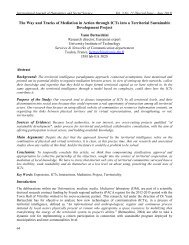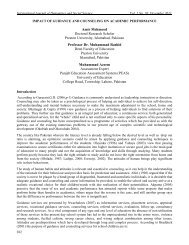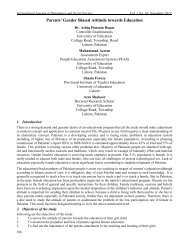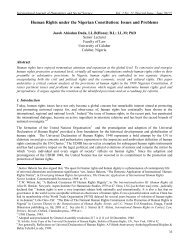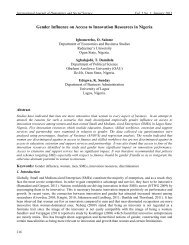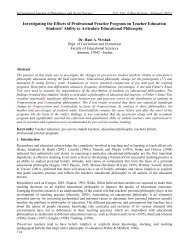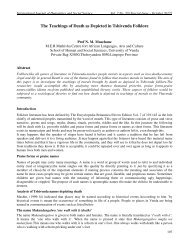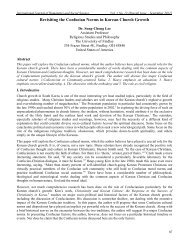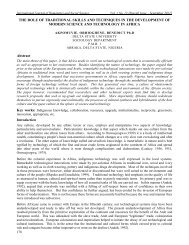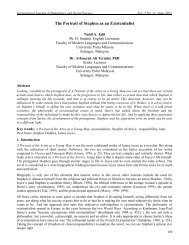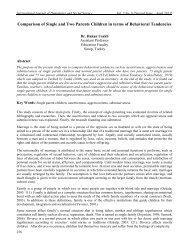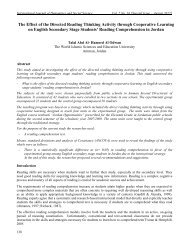Nutrition Habits of Women in Karapinar (Central Anatolia): Corrects ...
Nutrition Habits of Women in Karapinar (Central Anatolia): Corrects ...
Nutrition Habits of Women in Karapinar (Central Anatolia): Corrects ...
Create successful ePaper yourself
Turn your PDF publications into a flip-book with our unique Google optimized e-Paper software.
International Journal <strong>of</strong> Humanities and Social Science Vol. 2 No. 11; June 2012<br />
<strong>Nutrition</strong> <strong>Habits</strong> <strong>of</strong> <strong>Women</strong> <strong>in</strong> Karap<strong>in</strong>ar (<strong>Central</strong> <strong>Anatolia</strong>): <strong>Corrects</strong> and<br />
Incorrects<br />
Cıgdem SABBAG<br />
Adıyaman University<br />
School <strong>of</strong> Tourism, Food and Beverage Department<br />
02040, Adıyaman, Turkey<br />
Abstract<br />
The correct and <strong>in</strong>correct management <strong>of</strong> food preparation, cook<strong>in</strong>g and storage habits <strong>of</strong> women <strong>in</strong> Karapınar,<br />
<strong>Central</strong> <strong>Anatolia</strong> were determ<strong>in</strong>ed by questionnaires. Majority <strong>of</strong> the women were obese with grade I, II and III<br />
body type. Although socio-economic level <strong>of</strong> housewives are relatively high, <strong>in</strong>correct practices were determ<strong>in</strong>ed<br />
while us<strong>in</strong>g and stor<strong>in</strong>g vegetables, legumes, dairy products, oil and eggs that are all common <strong>in</strong> their daily<br />
nutrition. However, use <strong>of</strong> steel pan, s<strong>in</strong>gle use <strong>of</strong> fry<strong>in</strong>g oil and tim<strong>in</strong>g <strong>of</strong> sugar use for pudd<strong>in</strong>gs were correct<br />
practices. Thus, nutrition habits and knowledge <strong>of</strong> women <strong>in</strong> Karapınar are somewhat with<strong>in</strong> standards.<br />
However, enhanc<strong>in</strong>g the current knowledge is requested for better food process<strong>in</strong>g and good health which can be<br />
only available with education courses. S<strong>in</strong>ce <strong>in</strong>terviews revealed housewives will<strong>in</strong>gness to education courses,<br />
improper nutritional habits can be corrected by educational courses.<br />
Key words: Karapınar, nutrition habits, nutrition knowledge, food preparation, <strong>Central</strong> <strong>Anatolia</strong><br />
1. Introduction<br />
<strong>Nutrition</strong> culture and habits <strong>of</strong> humans, directly effect<strong>in</strong>g health, are shaped by society and affected by climate,<br />
agriculture, <strong>in</strong>dustrialization, migration, urbanization, media and technological developments. <strong>Nutrition</strong> can be<br />
def<strong>in</strong>ed as use <strong>of</strong> foods for growth, susta<strong>in</strong><strong>in</strong>g life and health, and nutrition aimed to provide required energy and<br />
elements accord<strong>in</strong>g to age, gender, activity and special conditions (Lloyd, Mcdonald, & Crampton, 1978; Geissler<br />
& Powers, 2009) . Majority <strong>of</strong> the people has <strong>in</strong>sufficient and/or <strong>in</strong>correct knowledge on nutritive value,<br />
preparation, cook<strong>in</strong>g and conservation/stor<strong>in</strong>g <strong>of</strong> foods as well as choos<strong>in</strong>g healthy ones (Friedman, 1996;<br />
Sabbağ, Sürücüoğlu, Özçelik, & Akan, 2006). Housewives knowledge on food <strong>in</strong>fluence household’s nutrition<br />
status. Thus, tra<strong>in</strong><strong>in</strong>g is a basic precaution for mitigat<strong>in</strong>g and avoid<strong>in</strong>g nutrition problems that may arise due to<br />
<strong>in</strong>correct knowledge <strong>of</strong> women on food preparation and cook<strong>in</strong>g (Brown, Mckenzie, &Yudk<strong>in</strong>, 1963; Walker,<br />
Walker, Jones, Duvenhage, & Mia, 1982; Hakeem, Asar, & Shaikh, 2004) . Tra<strong>in</strong><strong>in</strong>g can lead development <strong>of</strong><br />
sufficient and balanced nutrition habits, gett<strong>in</strong>g rid <strong>of</strong> bad nutrition habits, protect<strong>in</strong>g foods from deterioration<br />
which may all result efficient use <strong>of</strong> food sources (Potter, & Hotchkiss, 1995; Lentz, 1999; Topçu, Köksal, &<br />
Bilgili, 2003; Entis, 2007; Baysal, 2009) . Moreover, food type, stability <strong>of</strong> nutrient elements, cook<strong>in</strong>g water and<br />
time along with cook<strong>in</strong>g gadgets are affect<strong>in</strong>g loss <strong>of</strong> nutrients dur<strong>in</strong>g cook<strong>in</strong>g.<br />
Whatever the development level <strong>of</strong> the society and <strong>in</strong>creas<strong>in</strong>g women responsibility out <strong>of</strong> house do not change<br />
the traditional role <strong>of</strong> women even enhanced its position (Kumar, 2005), and ma<strong>in</strong> responsibility <strong>of</strong> women <strong>in</strong><br />
Turkey are still nutrition <strong>of</strong> the households wherever they live (Akp<strong>in</strong>ar, Talay, Ceylan, & Gündüz, 2004).<br />
2. Material and methods<br />
Study on food preparation <strong>of</strong> housewives is undertaken <strong>in</strong> Karapınar town, Konya (C. <strong>Anatolia</strong>). Karapınar has a<br />
population <strong>of</strong> 48.200 out <strong>of</strong> which 51% is women. Housewives constitute 86% <strong>of</strong> the female population (TUIK,<br />
2010). Ma<strong>in</strong> <strong>in</strong>come <strong>of</strong> the region is agriculture with animal husbandry. Average <strong>in</strong>come <strong>of</strong> the per capita <strong>in</strong><br />
Karapınar <strong>in</strong> terms <strong>of</strong> buy<strong>in</strong>g power is app. 6.800 US$ (TUIK, 2010). Thus, <strong>in</strong>terviewed women’s <strong>in</strong>come is<br />
with<strong>in</strong> the average <strong>of</strong> the country which is 8.500 US$ (TUIK, 2010).<br />
The body mass <strong>in</strong>dexes were evaluated accord<strong>in</strong>g to WHO (World Health Organisation standards, 2000).<br />
Interview was undertaken with 50 housewives <strong>in</strong> summer <strong>of</strong> 2010. The data was evaluated by SPSS 17.0<br />
s<strong>of</strong>tware.<br />
81
© Centre for Promot<strong>in</strong>g Ideas, USA www.ijhssnet.com<br />
3. Results<br />
3.1. Sample Characteristics <strong>of</strong> <strong>Women</strong> <strong>in</strong> Karapınar<br />
Ages <strong>of</strong> the women varied from 36 to 51 years with 1 to 3 children (Table 1). The body mass <strong>in</strong>dexes (BMI) <strong>of</strong><br />
surveyed women were generally obese with Grade I, II and III body type (World Health Organisation standards,<br />
2000). The frequency <strong>of</strong> obesity <strong>in</strong>creased with development <strong>of</strong> the country due to excess consumption <strong>of</strong> high<br />
energy foods and lack <strong>of</strong> daily exercise (K<strong>in</strong>g & W<strong>of</strong>ford, 2000). Thus, <strong>in</strong>tensive agriculture practices <strong>in</strong><br />
Karapınar s<strong>in</strong>ce 1990s <strong>in</strong>creased <strong>in</strong>come <strong>of</strong> the household. The <strong>in</strong>crease both <strong>in</strong> <strong>in</strong>come and obesity <strong>in</strong> Karapınar<br />
confirmed K<strong>in</strong>g and W<strong>of</strong>ford’s (K<strong>in</strong>g & W<strong>of</strong>ford, 2000) overall suggestions on l<strong>in</strong>ear relation <strong>of</strong> health<br />
problems and economical welfare.<br />
The prevalence <strong>of</strong> obesity (BMI≥30 kgm 2 ) is 33.9% <strong>in</strong> <strong>Central</strong> Turkey among women aged 15 to 49, which is<br />
31.9 <strong>in</strong> Western part and is 27.3% <strong>in</strong> Eastern part <strong>of</strong> the country (Koruk, & Şah<strong>in</strong>, 2005; Arslan, & Ceviz, 2007)<br />
whereas Flegal et al. (2005) determ<strong>in</strong>ed that obesity rate is 30.5% <strong>in</strong> USA for similar aged females and 20% <strong>of</strong> all<br />
adults <strong>in</strong> most European countries already obese (James, 2008). Thus, the obesity rate <strong>in</strong> Karapınar is the highest<br />
with<strong>in</strong> the country even higher than developed regions <strong>of</strong> the world which is an alarm<strong>in</strong>g state.<br />
3.2. Education, Career and Marital Status<br />
The mean educational level among is lower than high school (82%) with 62% elementary school education. Most<br />
<strong>of</strong> the women are housewives and 92% is married (Table 2).<br />
3.3. Exercise and Sport <strong>Habits</strong> <strong>of</strong> Females <strong>in</strong> Karapınar and Health Issues<br />
Follow<strong>in</strong>g mechanization <strong>in</strong> agriculture and availability <strong>of</strong> electronic house appliances <strong>in</strong> Karapınar, females’<br />
physical workload at farm and house were significantly reduced which negatively affected energy expenditure<br />
that all <strong>in</strong>creased BMI (Sabbag, 2012). Balanced and adequate diet should be supported by daily exercises for<br />
ma<strong>in</strong>ta<strong>in</strong><strong>in</strong>g body activities (Rolls, Drewnowski & Ledikwe, 2005). Increas<strong>in</strong>g BMI causes several health issues<br />
particularly hypertension, cardiovascular diseases, diabetes and jo<strong>in</strong>t diseases (Flegal, 2005). However, only 8%<br />
were gett<strong>in</strong>g daily exercise by walk<strong>in</strong>g. Compla<strong>in</strong>s on health was 56% and mostly on muscle, bone and jo<strong>in</strong>t<br />
diseases along with hypertension (Table 3).<br />
3.4. Eat<strong>in</strong>g <strong>Habits</strong> <strong>of</strong> <strong>Women</strong><br />
Most <strong>of</strong> the women use own plates, only 6% used shared-plates for eat<strong>in</strong>g, however 12 % uses own plate when<br />
there is a guest at home (Table 4). Mothers decide food type and cook<strong>in</strong>g style for the family (86%). Cheese and<br />
yogurt are generally prepared at home by housewives with 68%. More than half <strong>of</strong> the participants <strong>in</strong>dicated their<br />
eat<strong>in</strong>g speed normal and had 3 meals a day (Table 4). This eat<strong>in</strong>g habit ie 3 meals a day is a common practice <strong>in</strong><br />
Turkey (Sevenay, 1996; Sabbağ, Sürücüoğlu, Özçelik, & Akan, 2006).<br />
3.5. Vegetable process<strong>in</strong>g and storage practices<br />
Vegetables are consumed either raw or cooked <strong>in</strong> Karapınar traditional kitchen. However, cook<strong>in</strong>g or process<strong>in</strong>g<br />
at either consumption causes loss <strong>in</strong> vitam<strong>in</strong> constituents, particularly loss <strong>of</strong> vitam<strong>in</strong> C is related to amount <strong>of</strong><br />
cook<strong>in</strong>g water, time and type, type <strong>of</strong> casserole along with open or closed lid dur<strong>in</strong>g cook<strong>in</strong>g. 74% <strong>of</strong> the studied<br />
women shell-wash-chop vegetables before cook<strong>in</strong>g, 58% closed casserole lid while cook<strong>in</strong>g and 50% stored<br />
vegetables <strong>in</strong> fridge follow<strong>in</strong>g wash<strong>in</strong>g (Table 5). However, the right process which is wash<strong>in</strong>g-shell<strong>in</strong>g-chopp<strong>in</strong>g<br />
was practiced only by 26%. This low figure is also valid for several parts <strong>of</strong> the country (Sevenay, 1996; Güler, &<br />
Özçelik, 2002).<br />
Majority <strong>of</strong> the women poured away boiled water <strong>of</strong> vegetables, pasta and legumes (Table 4) and cooked pilaf by<br />
fry<strong>in</strong>g. However, sugar is added to milk pudd<strong>in</strong>gs close to ripen<strong>in</strong>g which is a right practice. Cook<strong>in</strong>g practice is<br />
<strong>of</strong> utmost importance for prevent<strong>in</strong>g nutrition quality <strong>of</strong> foods (Contento, 2010). Thus, women are <strong>in</strong>formed to<br />
stew or grill meat, cook legumes with boil<strong>in</strong>g water, add vegetables immediately after cutt<strong>in</strong>g to hot water, and<br />
vaporize boil<strong>in</strong>g water <strong>of</strong> pasta for cook<strong>in</strong>g for right cook<strong>in</strong>g practices. Ünver (1985), suggested 7 m<strong>in</strong>utes <strong>of</strong><br />
boil<strong>in</strong>g <strong>in</strong> 800ml <strong>of</strong> water <strong>in</strong> casserole best practice for conserv<strong>in</strong>g vitam<strong>in</strong> C. Moreover, as vitam<strong>in</strong> B and lys<strong>in</strong>e<br />
are degraded due to high temperature dur<strong>in</strong>g fry<strong>in</strong>g <strong>of</strong> rice along with occurrence <strong>of</strong> hazardous materials<br />
follow<strong>in</strong>g molecule deterioration, pilaf should be cooked by boil<strong>in</strong>g (Gershw<strong>in</strong>, German, & Keen, 2000). Sav<strong>in</strong>g<br />
boil<strong>in</strong>g water <strong>of</strong> legumes while cook<strong>in</strong>g is crucial for sav<strong>in</strong>g nutrition quality <strong>of</strong> meal (Contento, 2010). Thus,<br />
current food preparation <strong>in</strong> Karapınar is not <strong>in</strong> accordance with healthy food preparation techniques.<br />
82
International Journal <strong>of</strong> Humanities and Social Science Vol. 2 No. 11; June 2012<br />
3.6. Use <strong>of</strong> fry<strong>in</strong>g oil, whey and yogurt water<br />
Fry<strong>in</strong>g generally decreases nutrition value and deteriorates oil properties. Thus, fried foods should not dom<strong>in</strong>ate <strong>in</strong><br />
daily diet, however, for prevent<strong>in</strong>g negative effects <strong>of</strong> fry<strong>in</strong>g, contact with air should be prevented by deep fry<strong>in</strong>g<br />
and should not be used more than three times (Contento, 2010). Fifty six percent <strong>of</strong> the <strong>in</strong>terviewed women stated<br />
one time use <strong>of</strong> fry<strong>in</strong>g oils, 68% poured away whey and stored eggs <strong>in</strong> fridge follow<strong>in</strong>g wash<strong>in</strong>g. Table 6 shows<br />
that 38% <strong>of</strong> the participants cooked meat <strong>in</strong> oven, and 56% thought that oven cooked meat are more delicious.<br />
Stew<strong>in</strong>g generally known as healthy cook<strong>in</strong>g method for meat, poultry and fish, but there will be 70% <strong>of</strong> loss <strong>in</strong><br />
vitam<strong>in</strong> B if no boil<strong>in</strong>g water is used (Ruzi Roso, 1998). However, this loss decreased to 20% when oven, grill or<br />
microwave is used. Similar studies revealed majority <strong>of</strong> the housewives throughout the world cook meat by fry<strong>in</strong>g<br />
or grill<strong>in</strong>g (West, Joy, Murphy, Hudes, Bunch, & Wright, 1999). Most <strong>of</strong> the participants, 62%, keep boiled milk<br />
<strong>in</strong> fridge <strong>in</strong> closed pots.<br />
3.7. Casseroles used for cook<strong>in</strong>g<br />
In general, women prefer steel casserole for cook<strong>in</strong>g however other casseroles are also used for different cooks for<br />
example 60% used polytetrafluoroethylen (PTFE) casseroles for pilaf cook<strong>in</strong>g (Table 7). Therefore, casserole<br />
types used for cook<strong>in</strong>g <strong>in</strong> Karapınar is healthy. Studies on use <strong>of</strong> casseroles <strong>in</strong> the country revealed that steel<br />
casserole use is common which is followed by PTFE (Sevenay, 1996; Güler, & Özçelik, 2002; Topçu, Köksal, &<br />
Bilgili, 2003).<br />
3.8. Storage <strong>of</strong> Foods<br />
Stor<strong>in</strong>g food until consumption is as important as production. Participants <strong>of</strong> the survey <strong>in</strong>dicated that most <strong>of</strong> the<br />
food such as bread, cereals, legumes and sugar conta<strong>in</strong><strong>in</strong>g are stored primarily <strong>in</strong> kitchen cab<strong>in</strong>ets then fridge<br />
(Table 8).<br />
3.9. Food storage conta<strong>in</strong>ers<br />
Majority <strong>of</strong> the women <strong>in</strong> Karapınar prefers plastic bags for stor<strong>in</strong>g meat, milk and dairy products, oils <strong>in</strong> their<br />
orig<strong>in</strong>al pack, eggs <strong>in</strong> fridge shelves (Table 9). However, the <strong>in</strong>crease <strong>in</strong> use <strong>of</strong> plastic bags for storage is<br />
challeng<strong>in</strong>g s<strong>in</strong>ce stor<strong>in</strong>g liquid and semi-liquid foods <strong>in</strong> plastic bags that are not designed for food stor<strong>in</strong>g is<br />
dangerous for health. Although plastic bags should be used only once for stor<strong>in</strong>g foods multiple uses causes<br />
transition <strong>of</strong> hazardous chemicals to foods. This is more recognized for stor<strong>in</strong>g yogurt <strong>in</strong> its orig<strong>in</strong>al package.<br />
3.10. <strong>Nutrition</strong> Knowledge <strong>of</strong> women <strong>in</strong> Karapınar<br />
Majority <strong>of</strong> the women <strong>in</strong> Karapınar replied true answers to; milk as the most healthy dr<strong>in</strong>k (90%), citrus fruits<br />
are good for protect<strong>in</strong>g flu (92%), foods should be consumed <strong>in</strong> the morn<strong>in</strong>g, afternoon and even<strong>in</strong>g ie as three<br />
meals a day (90%), milk and dairy products provide calcium (60%). However, answers on types foods that should<br />
be banned for high tension (60%), best practices for los<strong>in</strong>g weight (78%), foods effect<strong>in</strong>g tooth decay<strong>in</strong>g (66%),<br />
mistakes <strong>of</strong> cook<strong>in</strong>g and stor<strong>in</strong>g foods (76%), illness related to excess use <strong>of</strong> oil (60%) were <strong>in</strong>accurate (Table<br />
10).<br />
4. Discussions<br />
Global population <strong>in</strong>crease <strong>in</strong>credibly boosted demand on foods. Thus, besides production <strong>of</strong> food, proper<br />
cook<strong>in</strong>g and stor<strong>in</strong>g practices are utmost important for global food security. Arid and semi-arid regions such as<br />
Karapınar <strong>in</strong> <strong>Central</strong> Turkey are/will face food security issues more than humid regions <strong>of</strong> the world due to<br />
limitations <strong>in</strong> agricultural production. Traditional knowledge notwithstand<strong>in</strong>g household <strong>in</strong>come on food<br />
process<strong>in</strong>g may sometimes <strong>in</strong>accurate particularly by women with lower education level alike Karapınar.<br />
Consequently, education is the ma<strong>in</strong> action from prevent<strong>in</strong>g nutrition problems which will lead to balanced and<br />
sufficient nutrition as well as gett<strong>in</strong>g rid <strong>of</strong> mistakes and <strong>in</strong>accurate practices that will case deterioration <strong>of</strong> foods.<br />
The study undertaken <strong>in</strong> Karapınar revealed that although <strong>in</strong>come <strong>of</strong> women is relatively high, knowledge on food<br />
cook<strong>in</strong>g and stor<strong>in</strong>g is not sufficient. Moreover, wrong food preparation <strong>in</strong> Karapınar leads development <strong>of</strong><br />
illnesses such as high tension and high BMI. However, acquiescence <strong>of</strong> women on education courses on food is<br />
pleas<strong>in</strong>g. By education courses, focus<strong>in</strong>g on women that are choos<strong>in</strong>g and plann<strong>in</strong>g food programs <strong>of</strong> the house,<br />
plenty <strong>of</strong> food can be saved and consumed <strong>in</strong> a proper way that will have positive effect both on limited food<br />
supply <strong>of</strong> globe and households health life.<br />
83
© Centre for Promot<strong>in</strong>g Ideas, USA www.ijhssnet.com<br />
Acknowledgement<br />
Authors wishes to express their pr<strong>of</strong>ound thanks to MITSUI Environment Fund for fund<strong>in</strong>g this study via CROP-<br />
MAL Project. Without their everlast<strong>in</strong>g support, this study would not have happened.<br />
References<br />
Akp<strong>in</strong>ar, N., Talay, I., Ceylan, C. & Gündüz, S. (2004). Rural <strong>Women</strong> And Agrotourism In The Context Of Susta<strong>in</strong>able<br />
Rural Development: A Case Study From Turkey. Kluwer Journal, 6; 473-486. doi:10.1007/s10668-005-5633.<br />
Arslan, C., & Ceviz, D. (2007). Evaluation Of Obesity Prevalence And Health Promot<strong>in</strong>g Life-Style Pr<strong>of</strong>iles Of Housewives<br />
And Work<strong>in</strong>g <strong>Women</strong>. Fırat University Journal Of Health Sciences, 21(5); 211-220.<br />
Baysal, A. (2009). <strong>Nutrition</strong>. Hatipoğlu Publications , Ankara.<br />
Brown A.M., Mckenzie, J.C. &Yudk<strong>in</strong>, J. (1963). Knowledge Of <strong>Nutrition</strong> Amongst Housewives In A London Suburb.<br />
International Journal Food Sciences <strong>Nutrition</strong>, 17;16-20.<br />
Contento, I.R. (2010). <strong>Nutrition</strong> Education: L<strong>in</strong>k<strong>in</strong>g Theory. Research And Practice. 2d Ed. Sudbury, Ma: Jones & Bartlett, 130-444.<br />
Entis L. (2007). Food Safety: Old <strong>Habits</strong>, New Perspectives. Asm Press. American Society For Microbiology. Wash<strong>in</strong>gton.<br />
Flegal, K.M., Graubard, B. İ., Williamson, D, F. & Gail M.H. (2005). Excess Deaths Associated With Underweight,<br />
Overweight And Obesity. JAMA, 293 1861-67.<br />
Friedman, M. (1996). <strong>Nutrition</strong>al Value Of Prote<strong>in</strong>s From Different Food Sources. A Review. Journal Agriculture Food<br />
Chemistry, 44(1) 6-29.<br />
Geissler, C. &Powers H. (2009). Fundamentals Of Human <strong>Nutrition</strong>: For Students And Practitioners In The Health Sciences.<br />
Churchill Liv<strong>in</strong>gstone, Elsevier, 128-295.<br />
Gershw<strong>in</strong>, M. E., German, J.B. & Keen, K.L. (2000). <strong>Nutrition</strong> And Immunology. Pr<strong>in</strong>ciples And Practices. Humana Press,<br />
New Jersey, 289-485.<br />
Güler, B. & Özçelik, A.Ö. (2002). A Research On The <strong>Habits</strong> Of Work<strong>in</strong>g And Unemployed <strong>Women</strong>’s Food Purchas<strong>in</strong>g And<br />
Process<strong>in</strong>g. Ankara.<br />
Hakeem, R., Asar, F., & Shaikh, A.H. (2004). Socioeconomic Differences In Housewife's Ability To Take <strong>Nutrition</strong>al Care,<br />
Journal Pakistan Medical Association, 54(7); 382-90.<br />
James, W.P.T. (2008).The Epidemiology Of Obesity: The Size Of The Problem. Journal International Medical, 263 36-52.<br />
K<strong>in</strong>g, D. S., W<strong>of</strong>ford, M. R. (2000). Obesity and Hypertension. Drug Topics, 3;59-67.<br />
Koruk, İ., Şah<strong>in</strong>, T.K. (2005). Prevalence And Risk Factors Of Obesity Among 15-49 Years-Old Housewives In<br />
Fazilet Uluışık Health District In Konya. Selçuk University, Faculty Of Medic<strong>in</strong>e, Public Health General Health<br />
Journal,15(4) 147-155.<br />
Kumar, A. (2005). Encyclopedia <strong>of</strong> <strong>Women</strong> In 21st Century. Anmol Publications, New Delhi, 256-433.<br />
Lentz, C. (1999). Chang<strong>in</strong>g Food <strong>Habits</strong>: Case Studies From Africa, South America And Europe. Harwood Academic<br />
Publishers. (Amsterdam) 155-288.<br />
Lloyd, L. E., Mcdonald B. E. &, Crampton E.W. (1978). Fundamentals Of <strong>Nutrition</strong>. WhFreeman Pub, San Francisco.<br />
Potter, N.N. & Hotchkiss, J.H. Food Science. 5th Ed, Chapman & Hall, (1995) 220-50.<br />
Rolls, B.İ, Drewnowski, A. & Ledikwe, J.H. (2005). Chang<strong>in</strong>g The Energy Density Of The Diet As A Strategy For Weight<br />
Management, Journal American Dietetic Association, 105; 98-103.<br />
Ruzi Roso, B. (1998). Vitam<strong>in</strong>s. Grasas Y Aceites 49. Fase. 3-4347-51.<br />
Sabbağ, Ç., Sürücüoğlu, M. S., Özçelik, A. Ö. & Akan, L. S. (2006). A Research On <strong>Nutrition</strong> Knowledge Of Elementary<br />
School Teachers: A Sample Of Turkey. Research On Education (Ed Ms Giannakaki, Gt Papanikos, Y Pozios And Jk<br />
Richards), Athens Institute For Education And Research. Athens.<br />
Sabbag, 2012. The Seasonal BMI Changes <strong>of</strong> Rural <strong>Women</strong> Liv<strong>in</strong>g <strong>in</strong> <strong>Anatolia</strong>. International Journal <strong>of</strong> Environmental<br />
Research and Public Health, 9(4):1159-1170.<br />
Sevenay, N. (1996). A Research on <strong>Nutrition</strong> Habit, Food Preparation, Cook<strong>in</strong>g Methods And Level Of Knowledge On<br />
<strong>Nutrition</strong> Of <strong>Women</strong> Work<strong>in</strong>g In Public Sector In Kayseri. Ms Thesis, Ankara University, Graduate School Of<br />
Applied Sciences, Ankara.<br />
Topçu, A., Köksal, E. & Bilgili, N. A. (2003). Survey To Determ<strong>in</strong>e The Level Of Knowledge, Beliefs And Attitudes In A<br />
15-49 Age Group Housewives On Cook<strong>in</strong>g Practices. Journal Turk Hygiene Experimental Biology, 60(3); 77-86.<br />
TUIK, 2010. Turkish Statistical Institute (2010). Prime M<strong>in</strong>istry Republic Of Turkey. Accessed On 4.10.2010. Available<br />
From: Http:// Www.TUIK.gov.tr<br />
Ünver, B. (1985). Food Preparation And Cook<strong>in</strong>g Techniques. M<strong>in</strong>istry <strong>of</strong> Education Publications. Ankara (In Turkish). 45.<br />
Walker, A. R., Walker, B. F., Jones, J., Duvenhage, A, Mia F. P. (1982). Knowledge Of <strong>Nutrition</strong> Among Housewives In<br />
Three South African Ethnic Groups, South African Medical Journal, 62(17); 605-10.<br />
West, E., Joy, A.B., Murphy, S., Hudes, M., Bunch, S., Wright, J. (1999). Food Preparation Practices Influence <strong>Nutrition</strong>.<br />
California Agriculture, 53(1), 29-2.<br />
World Health Organisation (WHO). (2000). Obesity: Prevent<strong>in</strong>g And Manag<strong>in</strong>g The Global Epidemic. Report on A Who<br />
Consultation Technical Report Series, No 894, 265.<br />
84
International Journal <strong>of</strong> Humanities and Social Science Vol. 2 No. 11; June 2012<br />
Table 1. Obesity and demographic characteristics <strong>of</strong> women<br />
Data N %<br />
Age (years)<br />
20-35 18 36.0<br />
36-51 26 52.0<br />
51-70 6 12.0<br />
BMI kg/m 2<br />
Underweight 4 8.0<br />
Healthy weight 15 30.0<br />
Pre-obese state 12 24.0<br />
Obesity Grade I 12 24.0<br />
Obesity Grade II 3 6.0<br />
Obesity Grade III 4 8.0<br />
Number <strong>of</strong> households<br />
1-3 14 28.0<br />
4-6 32 64.0<br />
7-9 4 8.0<br />
Number <strong>of</strong> child<br />
None 3 6.0<br />
1-3 38 76.0<br />
4-7 9 18.0<br />
Table 2. Education, occupation and marital status <strong>of</strong> women<br />
N %<br />
Level <strong>of</strong> education<br />
Illiterate 3 6.0<br />
Literate 3 6.0<br />
Primary 31 62.0<br />
Secondary 4 8.0<br />
High 6 12.0<br />
University 3 6.0<br />
Occupation<br />
Housewife 42 84.0<br />
Employe 4 8.0<br />
Public <strong>of</strong>ficer 3 6.0<br />
Retired - -<br />
Self-employed 1 2.0<br />
Marital status<br />
Married 46 92.0<br />
Divorced-widow 4 8.0<br />
Table 3. Exercise and health issues <strong>of</strong> women<br />
Regular Exercise <strong>Habits</strong> N %<br />
Always 4 8.0<br />
Frequently 26 52.0<br />
Never 20 40.0<br />
Type <strong>of</strong> Exercise<br />
None 20 40.0<br />
Walk<strong>in</strong>g 25 50.0<br />
Runn<strong>in</strong>g 2 4.0<br />
Physical exercise 3 6.0<br />
Health Compla<strong>in</strong>ts<br />
Exists 28 56.0<br />
None 22 44.0<br />
Total 50 100.0<br />
85
© Centre for Promot<strong>in</strong>g Ideas, USA www.ijhssnet.com<br />
Table 4. Eat<strong>in</strong>g <strong>Habits</strong> <strong>of</strong> women<br />
N %<br />
Table Meals<br />
Own plate 41 82.0<br />
Shared-plate 3 6.0<br />
Own plate when there is a visitor 6 12.0<br />
Decision <strong>of</strong> meal type<br />
Mother 43 86.0<br />
Father 4 8.0<br />
Child 3 6.0<br />
Convenience Food<br />
Available 16 32.0<br />
None 34 68.0<br />
Eat<strong>in</strong>g speed<br />
Fast 14 28.0<br />
Very slow 9 18.0<br />
Normal 27 54.0<br />
Number meals <strong>in</strong> a day<br />
Two 6 12.0<br />
Three 39 78.0<br />
Four 1 2.0<br />
Five 4 8.0<br />
Total 50 100.0<br />
Table 5. Vegetable process<strong>in</strong>g, cook<strong>in</strong>g and stor<strong>in</strong>g habits <strong>of</strong> women<br />
N %<br />
Before cook<strong>in</strong>g vegetables<br />
Shell<strong>in</strong>g-wash<strong>in</strong>g-chopp<strong>in</strong>g 37 74.0<br />
Wash<strong>in</strong>g-shell<strong>in</strong>g-chopp<strong>in</strong>g 13 26.0<br />
Do not care - -<br />
Stor<strong>in</strong>g vegetables<br />
In plastic bag, unwashed 10 20.0<br />
In fridge, washed 25 50.0<br />
In fridge, unwashed 15 30.0<br />
Boil<strong>in</strong>g water <strong>of</strong> vegetables<br />
Poured away 21 42.0<br />
Keeps 16 32.0<br />
Cooks without boil<strong>in</strong>g 12 24.0<br />
Irregular 1 2.0<br />
Boil<strong>in</strong>g water <strong>of</strong> legumes<br />
Poured away 27 54.0<br />
Keeps 23 46.0<br />
Cook<strong>in</strong>g pilaf<br />
Soaked <strong>in</strong> water 3 6.0<br />
Fry<strong>in</strong>g 44 88.0<br />
Wetted and <strong>in</strong> water 3 6.0<br />
Cook<strong>in</strong>g Pasta<br />
Vaporized boil<strong>in</strong>g water 27 54.0<br />
Poured away 23 46.0<br />
Add<strong>in</strong>g sugar to milk pudd<strong>in</strong>gs<br />
Before boil<strong>in</strong>g <strong>of</strong> milk 7 14.0<br />
When milk boils 12 24.0<br />
Just before ripen<strong>in</strong>g 26 52.0<br />
Does not care when 5 10.0<br />
86
International Journal <strong>of</strong> Humanities and Social Science Vol. 2 No. 11; June 2012<br />
Table 6. Use <strong>of</strong> fried oils, whey and yogurt water by women<br />
N %<br />
Frequency <strong>of</strong> fried oil use<br />
Once 28 56.0<br />
Twice 17 34.0<br />
Three times 4 8.0<br />
Four times 1 2.0<br />
Whey and yogurt water<br />
Uses 16 32.0<br />
Poured away 34 68.0<br />
Stor<strong>in</strong>g egg<br />
Stores unwashed 18 36.0<br />
Stores washed 32 64.0<br />
Meat Cook<strong>in</strong>g<br />
Grill 7 14.0<br />
Stew 14 28.0<br />
Fried 10 20.0<br />
Oven 19 38.0<br />
Reasons <strong>of</strong> meat cook<strong>in</strong>g<br />
More delicious 28 56.0<br />
For sav<strong>in</strong>g nutrient quality 3 6.0<br />
Cooks faster - -<br />
Preference 19 38.0<br />
Milk storage<br />
Boiled, open lid, fridge 6 12.0<br />
Boiled, closed lid, fridge 31 62.0<br />
Raw, fridge 6 12.0<br />
No storage 7 14.0<br />
Total 50 100.0<br />
Table 7. Casseroles types and preference <strong>of</strong> casseroles for certa<strong>in</strong> food cook<strong>in</strong>g by women<br />
Casserole Type Alum<strong>in</strong>um Steel Pottery PTFE<br />
S % S % S % S %<br />
Vegetables 5,0 10,0 33,0 66,0 5,0 10,0 7,0 14,0<br />
Meat 1,0 2,0 21,0 42,0 14,0 28,0 14,0 28,0<br />
Legume 3,0 6,0 37,0 74,0 3,0 6,0 7,0 14,0<br />
Pilaf 3,0 6,0 16,0 32,0 1,0 2,0 30,0 60,0<br />
Pasta 4,0 8,0 40,0 80,0 1,0 2,0 5,0 10,0<br />
Milk pudd<strong>in</strong>g 3,0 6,0 40,0 80,0 2,0 4,0 5,0 10,0<br />
Soup 5,0 10,0 40,0 80,0 1,0 2,0 4,0 8,0<br />
Table 8. Stor<strong>in</strong>g food<br />
Kitchen Fridge Deep freezer Cellar Total<br />
cupboard<br />
N % N % N % N % N %<br />
Bread 35 70.0 11 22.0 - - 4 8.0 50 100.0<br />
Cereals and legume 35 70.0 7 14.0 - - 8 16.0 50 100.0<br />
Fresh vegetables and fruits 7 14.0 43 86.0 - - - - 50 100.0<br />
Meat and meat products 1 2.0 25 50.0 24 48.0 - - 50 100.0<br />
Milk and dairy products 1 2.0 48 96.0 1 2.0 - - 50 100.0<br />
Egg 2 4.0 48 96.0 - - - - 50 100.0<br />
Oils 6 12.0 38 76.0 - - 6 12.0 50 100.0<br />
Sugar and sugar products 27 54.0 13 26.0 - - 10 20.0 50 100.0<br />
87
© Centre for Promot<strong>in</strong>g Ideas, USA www.ijhssnet.com<br />
Table 9. Food storage conta<strong>in</strong>ers<br />
Plastic Fabric<br />
Grease-pro<strong>of</strong> paper Own<br />
package<br />
Fridge<br />
shelf Canister Glass Jar<br />
N % N % N % N % N % N % N %<br />
Bread 42 84 - - - - 2 4 6 12 - - - -<br />
Cereals and legume 12 24 14 28 - - 3 6 10 20 - - 11 22<br />
Vegetables and fruits 8 16 - - 2 4 30 60 6 12 - - 4 8<br />
Meat and meat products 15 30 - - 3 6 22 44 9 18 - - 1 2<br />
Milk and dairy products 3 6 - - 2 4 21 42 12 24 6 12 6 12<br />
Egg 4 8 - - 3 6 4 8 37 74 2 4 - -<br />
Oils 3 6 - - 8 16 21 42 7 14 3 6 8 16<br />
Sugar and sugar products 19 38 - - - - 13 26 11 22 2 4 5 10<br />
T: True F: False<br />
Table 10. <strong>Nutrition</strong> Knowledge <strong>of</strong> women<br />
N %<br />
Which foods should be banned for high tension? T 20 40.0<br />
F 30 60.0<br />
What is the best practice for los<strong>in</strong>g weight? T 11 22.0<br />
F 39 78.0<br />
Which food is effective on tooth decay? T 17 34.0<br />
F 33 66.0<br />
Which is the best dr<strong>in</strong>k for health T 45 90.0<br />
F 5 10.0<br />
Which is the wrong practice for cook<strong>in</strong>g and stor<strong>in</strong>g T 12 24.0<br />
vegetables and fruits?<br />
F 38 76.0<br />
Which one protects aga<strong>in</strong>st flu T 46 92.0<br />
F 4 8.0<br />
When should foods consumed? T 45 90.0<br />
F 5 10.0<br />
What k<strong>in</strong>d <strong>of</strong> illness develops follow<strong>in</strong>g excess oil T 20 40.0<br />
consumption?<br />
F 30 60.0<br />
What milk and dairy products provide to humans? T 30 60.0<br />
F 20 40.0<br />
88




